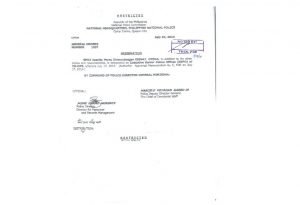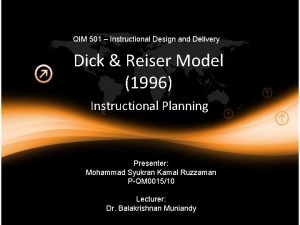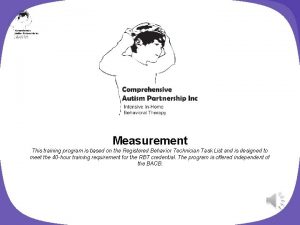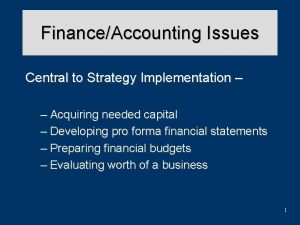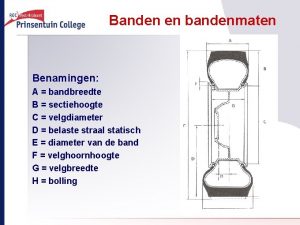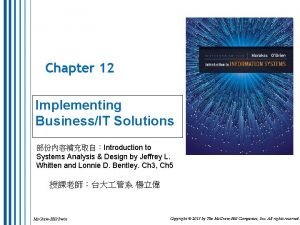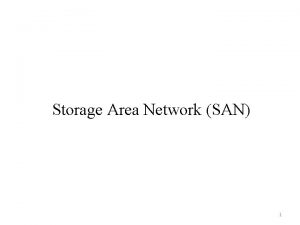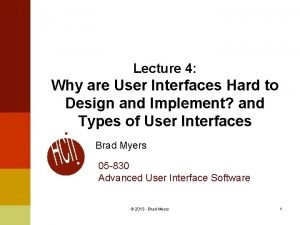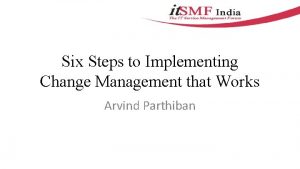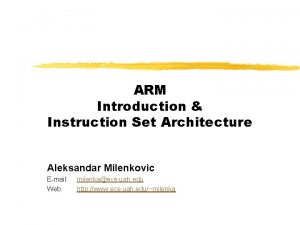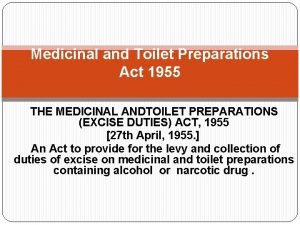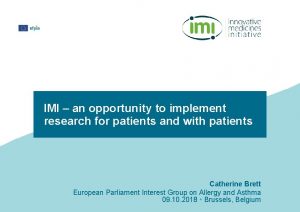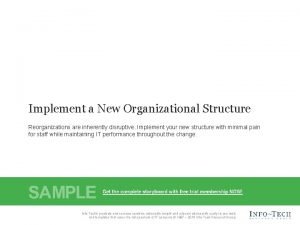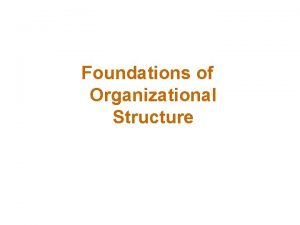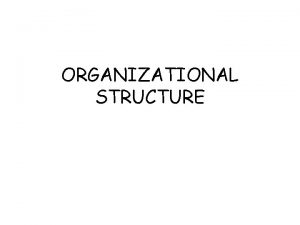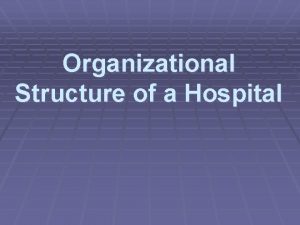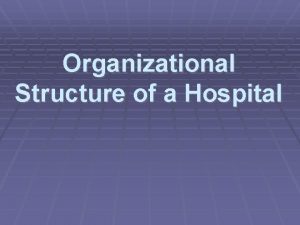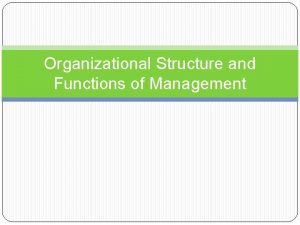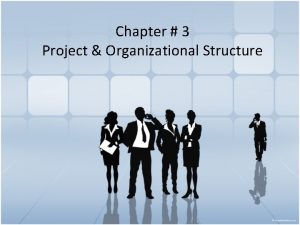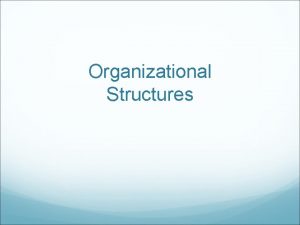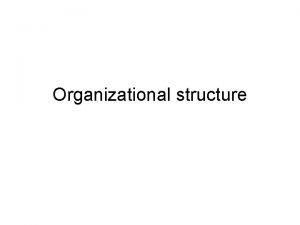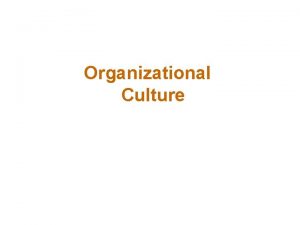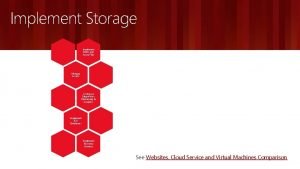V 4 Implement a New IT Organizational Structure




















- Slides: 20

V 4 Implement a New IT Organizational Structure Prioritize quick wins and critical services during IT org changes. Info-Tech Research Group, Inc. is a global leader in providing IT research and advice. Info-Tech’s products and services combine actionable insight and relevant advice with ready-to-use tools and templates that cover the full spectrum of IT concerns. © 1997 -2016 Info-Tech Research Group Inc. Info-Tech Research Group 1

This blueprint is part 3/3 in Info-Tech’s organizational design program and focuses on implementing a new structure PART 1: DESIGN IT Organizational Architecture 1. Define the organizational design objectives. 2. Develop strategicallyaligned capability map. 3. Create the organizational design framework. 4. Define the future state work units. 5. Create future state work unit mandates. Organizational Sketch 6. Assign work to work units (accountabilities and responsibilities). 7. Develop organizational model options (organizational sketches). 8. Assess options and select goforward model. PART 2: STRUCTURE PART 3: IMPLEMENT Organizational Structure Transition Strategy 9. Define roles by work unit. 10. Create role mandates. 11. Turn roles into jobs. 12. Define reporting relationships between jobs. 13. Define competency requirements. Organizational Chart 14. Determine number of positions per job. 15. Conduct competency assessment. 16. Assign staff to jobs. 17. Form OD implementation team. 18. Develop change vision. 19. Build communication presentation. 20. Identify and plan change projects. 21. Develop organizational transition plan. Implement Structure 22. Train managers to lead through change. 23. Define and implement stakeholder engagement plan. 24. Develop individual transition plans. 25. Implement transition plans. Risk Management: Create, implement, and monitor risk management plan. HR Management: Develop job descriptions, conduct job evaluation, and develop compensation packages. Monitor and Sustain Stakeholder Engagement The sections highlighted in green are in scope for this blueprint. Click here for more information on designing or on structuring a new organization. Info-Tech Research Group 2

Our understanding of the problem This Research Is is Designed For: This Research Will Help You: üCIOs üEffectively implement a new organizational structure. üDevelop effective communications to minimize turnover and lost productivity during transition. üIdentify a detailed transition strategy to move to your new structure with minimal interruptions to service quality. üTrain managers to lead through change and measure ongoing employee engagement. This Research Will Also Assist: This Research Will Help Them: You: üIT Leaders üEffectively lead through the organizational change. üManage difficult conversations with staff and mitigate staff concerns and turnover. üBuild clear transition plans for their teams. Info-Tech Research Group 3

Executive summary Situation Info-Tech Insight • Organizational Design (OD) projects are typically undertaken in order to 1. Mismanagement will hurt you. The majority of IT organizations do not manage OD implementations effectively, resulting in decreased satisfaction, productivity loss, and increased IT costs. enable organizational priorities, improve IT performance, or to reduce IT costs. However, due to the highly disruptive nature of the change, only 25% of changes achieve their objectives over the long term. 1 Complication • OD implementations can be highly disruptive for IT staff and business partners. Without a structured approach, IT leaders may experience high turnover, decreased productivity, and resistance to the change. • CIOs walk a tightrope as they manage the operational and emotional turbulence while aiming to improve business satisfaction within IT. Failure to achieve balance could result in irreparable failure. 2. Preventing mismanagement is within your control. 72% of change management issues can be directly improved by managers. 2 IT leaders have a tendency to focus their efforts on operational changes rather than on people. This is a recipe for failure. Resolution • Leverage Info-Tech’s organizational design implementation process and deliverables to build and implement a detailed transition strategy and to prepare managers to lead through change. Follow Info-Tech’s 5 -step process to: 1. Effect change and sustain productivity through real-time employee engagement monitoring. 2. Kick off the organizational design implementation with effective communication. 3. Build an integrated departmental transition strategy. 4. Train managers to effectively lead through change. 5. Develop personalized transition plans. 1 2013 Towers Watson Change and Communication ROI Survey 2 Abilla, 2009 Info-Tech Research Group 4

Organizational Design Implementation Managing organizational design (OD) changes effectively is critical to maintaining IT service levels and retaining top talent throughout a restructure. Nevertheless, many organizations fail to invest appropriate consideration and resources into effective OD change planning and execution. THREE REASONS WHY CIOS NEED TO EFFECTIVELY MANAGE CHANGE: 1 2 3 Failure is the norm; not the exception. According to a study by Towers Watson, only 55% of organizations experience the initial value of a change. Even fewer organizations, a mere 25%, are actually able to sustain change 2 over time to experience the full expected benefits. People are the biggest cause of failure. Organizational design changes are one of the most difficult types of changes to manage as staff are often highly resistant. This leads to decreased productivity and poor results. The most significant people challenge is the loss of momentum through the change process which needs to be actively managed. Failure costs money. Poor IT OD implementations can result in increased turnover, lost productivity, and decreased satisfaction from the business. Managing the implementation has a clear ROI as the cost of voluntary turnover is estimated to be 150% of an employee’s annual salary. 3 2 2013 Towers Watson Change and Communication ROI Survey 3 Inc. Info-Tech Research Group 5

86% of IT leaders believe organization and leadership processes are critical, yet the majority struggle to be effective GAP BETWEEN IMPORTANCE AND EFFECTIVENESS PERCENTAGE OF IT LEADERS WHO BELIEVE THEIR ORGANIZATION AND LEADERSHIP PROCESSES ARE HIGHLY IMPORTANT AND HIGHLY EFFECTIVE Human Resources Management 61% Leadership, Culture, Values 48% Organizational Change Management 55% Organizational Design 45% 0% High Importance 50% High Effectiveness 100% Note: Importance and effectiveness were determined by identifying the percentage of individuals who responded with 8 -10/10 to the questions… • “How important is this process to the organization’s ability to achieve business and IT goals? ” and… • “How effective is this process at helping the organization to achieve business and IT goals? ” Source: Info-Tech Research Group, Management and Governance Diagnostic. N=22, 800 IT Professionals Info-Tech Research Group 6

Follow a structured approach to your OD implementation to improve stakeholder satisfaction with IT and minimize risk • • • IT reorganizations are typically undertaken to enable strategic goals, improve efficiency and performance, or because of significant changes to the IT budget. Without a structured approach to manage the organizational change, IT might get the implementation done, but fail to achieve the intended benefits, i. e. the operation succeeds, but the patient has died on the table. When implementing your new organizational design, it’s critical to follow a structured approach to ensure that you can maintain IT service levels and performance and achieve the intended benefits. The impact of organizational structure changes can be emotional and stressful for staff. As such, in order to limit voluntary turnover, and to maintain productivity and performance, IT leaders need to be strategic about how they communicate and respond to resistance to change. TOP 3 BENEFITS OF FOLLOWING A STRUCTURED APPROACH TO IMPLEMENTING ORGANIZATIONAL DESIGN 1 Improved stakeholder satisfaction with IT. A detailed change strategy will allow you to successfully transition staff into new roles with limited service interruptions and with improved stakeholder satisfaction. 2 Experience minimal voluntary turnover throughout the change. Know how to actively engage and minimize resistance of stakeholders throughout the change. 3 Execute implementation on time and on budget. Effectively managed implementations are 65– 80%1 more likely to meet initial objectives than those with poor organizational change management. 1 Boxley Group, LLC Info-Tech Research Group 7

Optimize your organizational design implementation results by actively preparing managers to lead through change IT leaders have a tendency to make change even more difficult by focusing on operations rather than on people. This is a recipe for failure. People pose the greatest risk to effective implementation and as such, IT managers need to be prepared and trained on how to lead their staff through the change. This includes knowing how to identify and manage resistance, communicating the change, and maintaining positive momentum with staff. Staff resistance and momentum are the most challenging part of leading through change 2 Reasons why change fails: 72% of failures can be directly improved by the manager 1 Dealing with technical issues 14% Monitoring metrics to measure progress 33% 14% Amending policies and processes Coordinating with stakeholders Getting buy-in from staff 32% 29% 39% 16% Maintaining a positive momentum with staff 0% 10%20%30%40%50%60%70% Most difficult aspects of Change Management 2 Mc. Lean & Company, N=196 Management behavior not supportive of change Employee resistance to change Inadequate resources or budget All other obstacles 1 shmula Info-Tech Research Group 8

Leverage organizational change management (OCM) best practices for increased OD implementation success Percent of respondents that met or exceeded project objectives Effective change management correlates with project success 100% 95% 80% 70% 95% Of projects with excellent change management met or EXCEEDED OBJECTIVES, vs. 15% of those with poor OCM. 1 60% 50% 49% 40% 143% 30% 20% 17% 0% Poor Fair Good Excellent Overall effectiveness of change management program Source: Prosci. From Prosci’s 2012 Best Practices in Change Management benchmarking report. ROI on projects with excellent OCM. In other words, for every dollar spent on the project, the company GAINS 43 CENTS. This is in contrast to 35% ROI on projects with poor OCM. 2 1 2 Prosci Mc. Kinsey Info-Tech Research Group 9

Info-Tech’s approach to OD implementation is a practical and tactical adaptation of several successful OCM models BUSINESS STRATEGY-ORIENTED OCM MODELS. John Kotter’s 8 -Step model, for instance, provides a strong framework for transformational change but doesn’t specifically take into account the unique needs of an IT transformation. References and Further Reading GENERAL-PURPOSE OCM FRAMEWORKS such as ACMP’s Standard for Change Management, CMI’s CMBo. K, and Prosci’s ADKAR model are very comprehensive and need to be configured to organizational design implementation-specific initiatives. • COBIT 5 • ADKAR (Prosci) • CMBo. K (CMI) • Kotter’s 8 Principles • Managing Transitions • Kubler-Ross Curve COBIT MANAGEMENT PRACTICE BAI 05: MANAGE ORGANIZATIONAL CHANGE ENABLEMENT follows a structured process for implementing enterprise change quickly. This framework can be adapted to OD implementation; however, it is most effective when augmented with the people and management training elements present in other frameworks. • The Classic Change Curve • Standard for Change Management (ACMP) Tailoring a comprehensive, general-purpose OCM framework to an OD implementation requires familiarity and experience. Info-Tech’s OD implementation model adapts the best practices from a wide range of proven OCM models and distills it into a step-by-step process that can be applied to an organizational design transformation. Info-Tech Research Group 10

The following OD implementation symptoms can be avoided through structured planning IN PREVIOUS ORGANIZATIONAL CHANGES, I’VE EXPERIENCED… “Difficultly motivating my staff to change. ” “Higher than average voluntary turnover during and following the implementation. ” “An overall sense of staff frustration or decreased employee engagement. ” “Decreased staff productivity and an inability to meet SLAs. ” “Increased overtime caused by being asked to do two jobs at once. ” “Confusion about the reporting structure during the change. ” “Difficulty keeping up with the rate of change and change fatigue from staff. ” “Business partner dissatisfaction about the change and complaints about the lack of effort or care put in by IT employees. ” “Business partners not wanting to adjust to the change and continuing to follow outdated processes. ” “Decrease in stakeholder satisfaction with IT. ” “Increased prevalence of shadow IT during or following the change. ” “Staff members vocally complaining about the IT organization and leadership team. ” Info-Tech Research Group 11

Follow this blueprint to develop and execute on your OD implementation IT leaders often lack the experience and time to effectively execute on organizational changes. Info-Tech’s organizational design implementation program will provide you with the needed tools, templates, and deliverables. Use these insights to drive action plans and initiatives for improvement. HOW WE CAN HELP ü Measure the ongoing engagement of your employees using Info-Tech’s MLI diagnostic. The diagnostic comes complete with easily customizable reports to track and act on employee engagement throughout the life of the change. ü Use Info-Tech’s customizable project management tools to identify all of the critical changes, their impact on stakeholders, and mitigate potential implementation risks. ü Develop an in-depth action plan and transition plans for individual stakeholders to ensure that productivity remains high and that service levels and project expectations are met. ü Align communication with real-time staff engagement data to keep stakeholders motivated and focused throughout the change. ü Use Info-Tech’s detailed facilitation guide to train managers on how to effectively communicate the change, manage difficult stakeholders, and help ensure a smooth transition. Info-Tech Research Group 12

Leverage Info-Tech’s customizable deliverables to execute your organizational design implementation ONGOING ENGAGEMENT MONITORING AND COMMUNICATION 3. 1 TRAIN MANAGERS TO LEAD THROUGH CHANGE 2. BUILD THE ORGANIZATIONAL TRANSITION PLAN 1. BUILD A CHANGE COMMUNICATION STRATEGY 3. 2 TRANSITION STAFF TO NEW ROLES COMMUNICATION STRATEGY ITERATION CUSTOMIZABLE PROJECT DELIVERABLES • • • Mc. Lean Leadership Index: Real-Time Employee Engagement Dashboard Organizational Design Implementation Kick-Off Presentation Organizational Design Implementation FAQ • Organizational Design Implementation Project Planning Tool • • Organizational Design Implementation Manager Training Guide Organizational Design Implementation Transition Plan Template Info-Tech Research Group 13

Leverage Info-Tech’s tools and templates to overcome key engagement program implementation challenges KEY SECTION INSIGHTS: METRICS: 1. Voluntary turnover: Conduct an exit interview with all staff members during and after transition. Identify any staff members who cite the change as a reason for departure. For those who do leave, multiply their salary by 1. 5% (the cost of a new hire) and track this over time. BUILD A CHANGE COMMUNICATION STRATEGY Effective organizational design implementations mitigate the risk of turnover and lost productivity through ongoing monitoring and managing of employee engagement levels. Take a data-driven approach to managing engagement with Info-Tech’s real-time MLI engagement dashboard and adjust your communication and implementation strategy before engagement risks become issues. BUILD THE ORGANIZATIONAL TRANSITION PLAN Your organizational design implementation is made up of a series of projects and needs to be integrated into your larger project schedule. Too often, organizations attempt to fit the organizational design implementation into their existing schedules which results in poor resource planning, long delays in implementation, and overall poor results. 2. Business satisfaction trends: Conduct CIO Business Vision one year prior to the change vs. one year after change kick-off. Prior to the reorganization, set metrics for each category for six months after the reorganization, and one year following. LEAD STAFF THROUGH THE REORGANIZATION The majority of IT managers were promoted because they excelled at the technical aspect of their job rather than in people management. Not providing training is setting your organization up for failure. Train managers to effectively lead through change to see a 72% decrease in change management issues. 1 3. Saved development costs: Number of hours to develop internal methodology, tools, templates, and process multiplied by the salary of the individual. 1 Info-Tech Research Group Abilla, 2009 14

Use this blueprint to save 1– 3 months in implementing your new organizational structure Time and Effort Using Blueprint Without Blueprint 1 person ½ day – 4 weeks 1– 2 hours for diagnostic set up (allow extra 4 weeks to launch and review initial results). High Value 4– 8 weeks Set Up the Departmental Change Workbooks 1– 5 people 1 day 4– 5 hours (varies based on the scope of the change). Medium Value 1– 2 weeks Design Transition Strategy 1– 2 people 1 day 2– 10 hours of implementation team’s time. Medium Value 0– 2 weeks Train Managers to Lead Through Change 1– 5 people 1– 2 weeks 1– 2 hours to prepare training (allow for 3– 4 hours per management team to execute). High Value 3– 5 weeks Assess Current and Ongoing Engagement These estimates are based on reviews with Info-Tech clients and our experience creating the blueprint. Workshop: 1 week GI/DIY: 2– 6 weeks Totals Time & Effort Saved: 8– 17 weeks Info-Tech Research Group 15

CIO uses holistic organizational change management strategies to overcome previous reorganization failures CASE STUDY Industry Manufacturing Source Client Interview Problem When the CIO of a large manufacturing company decided to undertake a major reorganization project, he was confronted with the stigma of a previous CIO’s attempt. Senior management at the company were wary of the reorganization since the previous attempt had failed and cost a lot of money. There was major turnover since staff were not happy with their new roles costing $250, 000 for new hires. The IT department saw a decline in their satisfaction scores and a 10% increase in help desk tickets. The reorganization also cost the department $400, 000 in project rework. Solution The new CIO used organizational change management strategies in order to thoroughly plan the implementation of the new organizational structure. The changes were communicated to staff in order to improve adoption, every element of the change was mapped out, and the managers were trained to lead their staff through the change. Results The reorganization was successful and eagerly adopted by the staff. There was no turnover after the new organizational structure was implemented and the engagement levels of the staff remained the same. $250, 000 Cost of new hires and salary changes 10% Increase in help desk tickets $400, 000 Cost of project delays due to the poorly effective implementation of changes Info-Tech Research Group 16

Use these icons to help direct you as you navigate this research Use these icons to help guide you through each step of the blueprint and direct you to content related to the recommended activities. This icon denotes a slide where a supporting Info-Tech tool or template will help you perform the activity or step associated with the slide. Refer to the supporting tool or template to get the best results and proceed to the next step of the project. This icon denotes a slide with an associated activity. The activity can be performed either as part of your project or with the support of Info-Tech team members, who will come onsite to facilitate a workshop for your organization. Info-Tech Research Group 17

Info-Tech offers various levels of support to best suit your needs DIY Toolkit “Our team has already made this critical project a priority, and we have the time and capability, but some guidance along the way would be helpful. ” Guided Implementation Workshop Consulting “Our team knows that we need to fix a process, but we need assistance to determine where to focus. Some check-ins along the way would help keep us on track. ” “We need to hit the ground running and get this project kicked off immediately. Our team has the ability to take this over once we get a framework and strategy in place. ” “Our team does not have the time or the knowledge to take this project on. We need assistance through the entirety of this project. ” Diagnostics and consistent frameworks used throughout all four options Info-Tech Research Group 18

Implement a New Organizational Structure 3. Lead Staff Through the Reorganization 1. Build a Change Communication Strategy 1. 1 Launch the Mc. Lean Leadership Index to set a baseline. 1. 2 Establish your implementation team. Best-Practice Toolkit 2. 1 Build a holistic list of change projects. 2. 2 Monitor and track the progress of your change projects. 1. 3 Build your change communication strategy and change vision. Set up your MLI Survey. Determine the members and roles of your implementation team. Guided Implementations 2. Build the Organizational Transition Plan Review the components of a change communication strategy. Review the change dimensions and how they are used to plan change projects. Review the list of change projects. 3. 1 Train Managers to Lead Through Change 3. 1. 1 Conduct a workshop with managers to prepare them to lead through the change. 3. 1. 2 Build stakeholder engagement plans and conduct conflict style selfassessments. 3. 2 Transition Staff to New Roles 3. 2. 1 Build transition plans for each of your staff members. 3. 2. 2 Transition your staff to their new roles. Review the materials and practice conducting the workshop. Review the individual transition plan and the process for completing it. Debrief after conducting the workshop. Final consultation before transitioning staff to their new roles. Module 1: Effectively communicate the reorganization to your staff. Module 2: Build the organizational transition plan. Module 3. 1: Train your managers to lead through change. Module 3. 2: Complete your transition plans. Phase 1 Results: • Plans for effectively communicating with your staff. Phase 2 Results: • A holistic view of the portfolio of projects required for a successful reorg. Phase 3. 1 Results: • A management team that is capable of leading their staff through the reorganization. Phase 3. 2 Results: • Completed transition plans for your entire staff. Onsite Workshop Info-Tech Research Group 19

Workshop overview Deliverables Activities Contact your account representative or email Workshops@Info. Tech. com for more information. Workshop Day 1 Workshop Day 2 Workshop Day 3 Workshop Day 4 Workshop Day 5 Build Your Change Project Plan Finalize Change Project Plan Enlist Your Implementation Team Train Your Managers to Lead Through Change Build Your Transition Plans 1. 1 Review the new organizational structure. 1. 2 Determine the scope of your organizational changes. 1. 3 Review your MLI results. 1. 4 Brainstorm a list of projects to enable the change. 2. 1 Brainstorm the tasks that are contained within the change projects. 2. 2 Determine the resource allocation for the projects. 2. 3 Understand the dependencies of the projects. 2. 4 Create a progress monitoring schedule. 3. 1 Determine the members that are best suited for the team. 3. 2 Build a RACI to define their roles. 3. 3 Create a change vision. 3. 4 Create your change communication strategy. 4. 1 Conduct the manager training workshop with managers. 4. 2 Review the stakeholder engagement plans. 4. 3 Review individual transition plan template with managers. 5. 1 Bring managers back in to complete transition plans. 5. 2 Revisit new organizational design as a source for information. 5. 3 Complete aspects of the template that do not require feedback. 5. 4 Discuss strategies for transitioning. 1. Mc. Lean Leadership Index Dashboard 2. Organizational Design Implementation Project Planning Tool 1. Completed Organizational Design Implementation Project Planning Tool 1. Communication Strategy 1. Stakeholder Engagement Plans 2. Conflict Style Self. Assessments 3. Organizational Design Implementation Transition Plan Template 1. Organizational Design Implementation Transition Plan Template Info-Tech Research Group 20
 Pnp organizational structure and their functions
Pnp organizational structure and their functions Reiser implement
Reiser implement Permanent product recording data sheet
Permanent product recording data sheet Implement guidance hitch
Implement guidance hitch Acquiring capital to implement strategies
Acquiring capital to implement strategies Mis issues in strategy implementation
Mis issues in strategy implementation Implement profiel banden
Implement profiel banden Eschew the implement of correction and vitiate the scion
Eschew the implement of correction and vitiate the scion Implement tasks that promote reasoning and problem solving
Implement tasks that promote reasoning and problem solving Implement food safety procedures
Implement food safety procedures Implement food safety procedures
Implement food safety procedures Develop vs implement
Develop vs implement Your startup wants to implement an order fulfillment
Your startup wants to implement an order fulfillment Secondary storage device definition
Secondary storage device definition Polynomial addition using linked list in c++
Polynomial addition using linked list in c++ Why are user interfaces hard to implement
Why are user interfaces hard to implement Change advisory board
Change advisory board Arm high speed multiplier organization
Arm high speed multiplier organization Swing components
Swing components Toilet preparation act 1955
Toilet preparation act 1955 Implement imi
Implement imi
